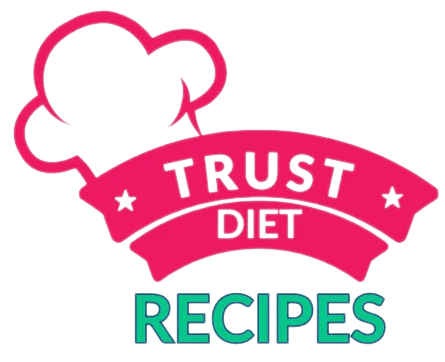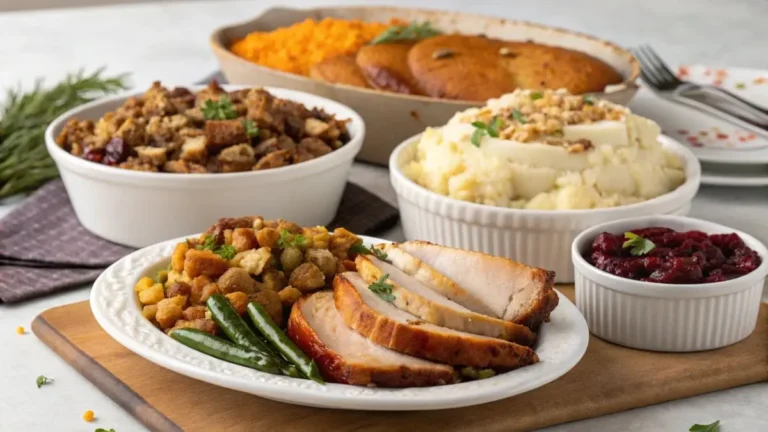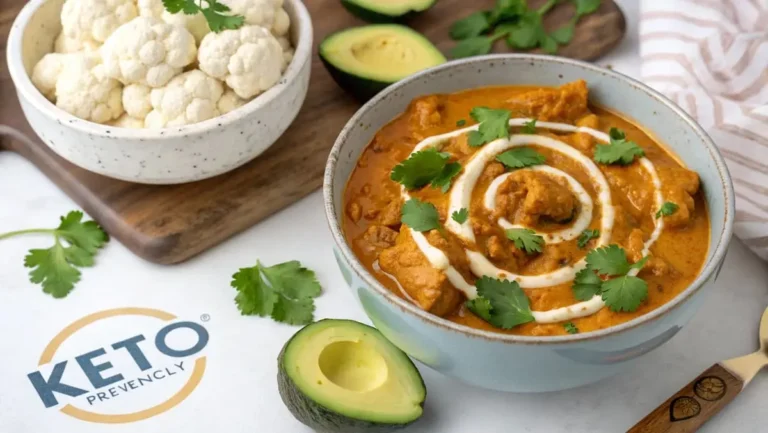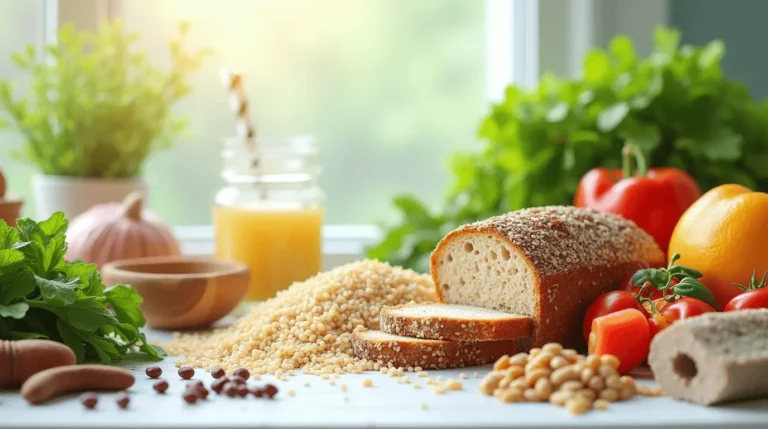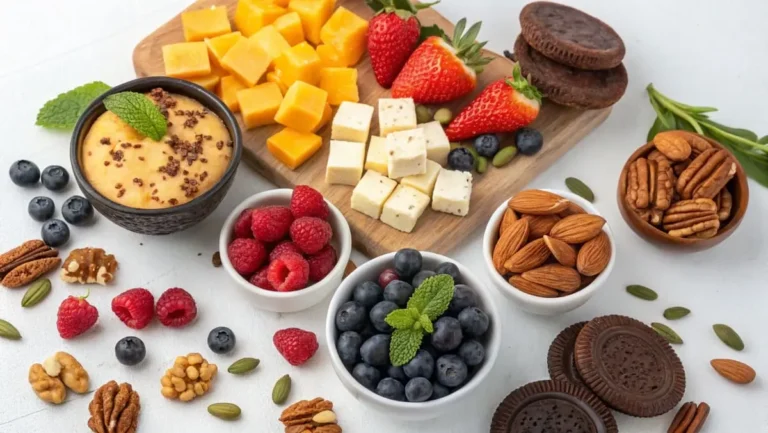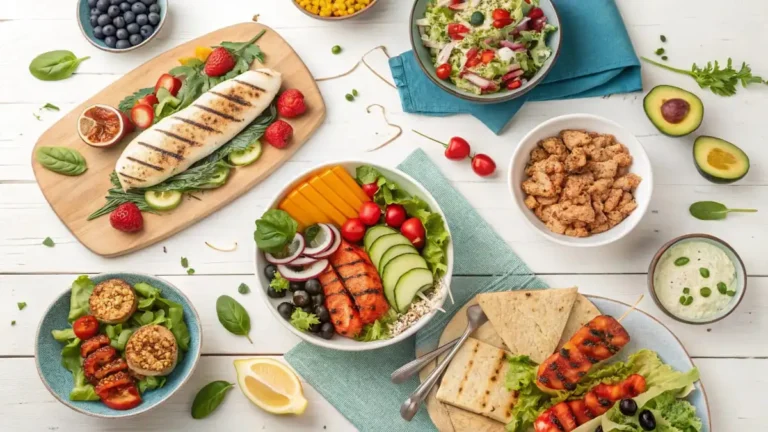Stay Full Longer: The Best Healthy Gluten Free Snacks Guide
Maintaining a healthy and fulfilling gluten-free diet often involves careful planning, especially regarding snacking. Many commercially available gluten free snacks are loaded with added sugars, unhealthy fats, and artificial ingredients, leaving you feeling unsatisfied and craving more. This comprehensive guide provides a wide range of healthy gluten free snack ideas, recipes, and tips to keep you full, energized, and satisfied between meals.
Table of Contents
The Importance of Choosing the Right Gluten Free Snacks
Selecting the right snacks is crucial for maintaining a balanced gluten-free diet. The ideal snack should be:
- Nutrient-rich: Provides essential vitamins, minerals, and fiber.
- High in Protein and/or Fiber: Promotes satiety, preventing excessive hunger and cravings.
- Low in Added Sugar and Unhealthy Fats: Avoids unnecessary calories and blood sugar spikes.
- Convenient and Portable: Easy to pack and enjoy on the go.
Categories of Healthy Gluten Free Snacks
This section categorizes healthy gluten free snack options based on nutritional profiles and characteristics.
1. High-Protein Snacks:
These snacks are excellent for promoting satiety and preventing hunger pangs.
- Hard-boiled eggs: A great source of protein and essential nutrients.
- Greek Yogurt: High in protein and calcium. Choose plain varieties and add your fruit or honey for sweetness.
- Nuts and Seeds: Almonds, walnuts, cashews, chia seeds, flax seeds, and pumpkin seeds are packed with protein, fiber, and healthy fats. A handful is a perfect portion.
- Edamame: Steamed edamame provides a good plant-based protein and fiber source.
- Lentils: A nutritious and versatile legume. Prepare a lentil salad or use lentils in soups or stews for a protein-rich addition.
- Protein Bars (Gluten-Free & Low Sugar): Choose carefully, checking labels for low added sugar and high protein content.
- Jerky (Beef, Turkey, or Salmon): A convenient high-protein snack. Opt for varieties without added sugar or excessive sodium.
2. High-Fiber Snacks:
Fiber promotes digestive health and helps you feel full for longer.
- Fruits: Apples, bananas, berries, oranges, and other fruits provide natural sweetness and fiber.
- Vegetables: Carrots, celery, bell peppers, cucumber, and other vegetables are low in calories and high in fiber. Pair with hummus or guacamole for added flavor and healthy fats.
- Popcorn (Air-Popped): A whole-grain snack that’s low in calories and high in fiber. Avoid buttery or heavily salted varieties.
- Legumes: Lentils, chickpeas, and other legumes are excellent sources of fiber and plant-based protein.
- Gluten-Free Whole Grains: Brown rice cakes, quinoa, and certified gluten-free oats provide fiber and sustained energy.
3. Healthy Fat Snacks:
Healthy fats are essential for satiety, nutrient absorption, and overall health.
- Avocado: Rich in monounsaturated fats, fiber, and potassium. Enjoy half an avocado with some salt and pepper or add it to a salad or sandwich.
- Nuts and Seeds: Almonds, walnuts, chia seeds, and other nuts and seeds provide healthy fats, protein, and fiber.
- Nut Butter (Natural): Peanut butter, almond butter, and other nut butter are great sources of healthy fats and protein. Choose varieties without added sugar or salt.
- Olive Oil: A healthy fat that can be used in dips or drizzled over salads and vegetables.
4. Other Satisfying Gluten Free Snacks:
- Dark Chocolate (70% cacao or higher): Provides antioxidants and can satisfy sweet cravings. Enjoy a small square or two.
- Plain Yogurt with Berries: High in protein and antioxidants.
- Homemade Gluten-Free Snack Bars: Making your own allows you to control the ingredients and ensures they’re healthy and delicious (recipes below).
Delicious and Nutritious Gluten Free Snack Recipes
1. No-Bake Energy Bites
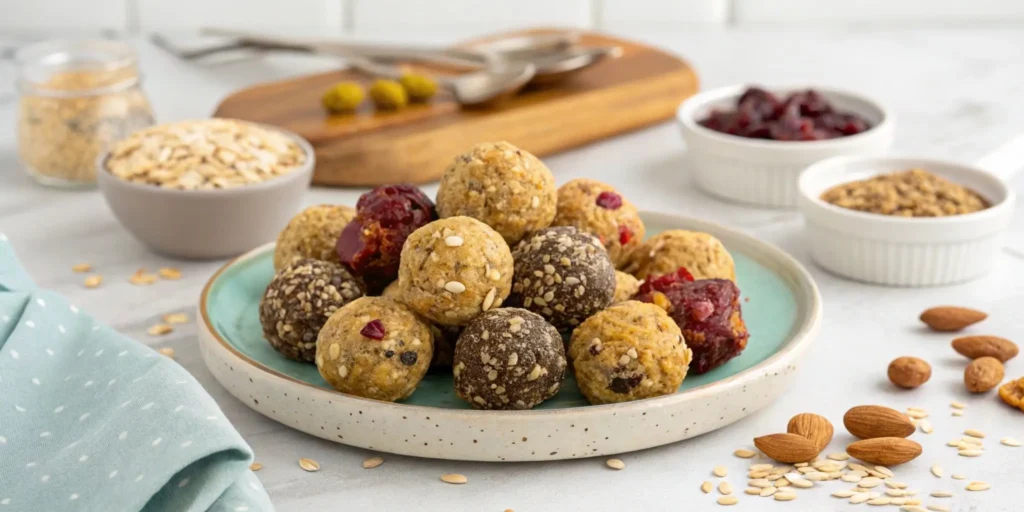
These energy bites are easy to make, require no baking, and are packed with protein, fiber, and healthy fats.
Ingredients:
- 1 cup gluten-free rolled oats (certified)
- 1/2 cup peanut butter (natural, no added sugar)
- 1/4 cup honey or maple syrup
- 1/4 cup mini chocolate chips (dairy-free optional)
- 1/4 cup shredded coconut (unsweetened)
Instructions:
- Combine oats, peanut butter, honey/maple syrup, chocolate chips, and coconut in a bowl. Mix well until a dough forms.
- Roll the mixture into small balls (about 1 inch in diameter).
- Refrigerate for at least 30 minutes to firm up.
Estimated Nutritional Information per Bite (assuming a recipe yields approximately 15-20 bites):
- Calories: 100-150 kcal
- This will vary depending on the fat content of your nut butter and the amount of added ingredients like chocolate chips.
- Macronutrients:
- Fat: 6-10g
- Saturated Fat: 1-2g (primarily from coconut oil, if used, and nuts)
- Unsaturated Fat: 4-8g (primarily from nut butter and seeds – healthy fats!)
- Trans Fat: 0g (assuming no hydrogenated oils are used)
- Cholesterol: 0-5mg (negligible)
- Sodium: 20-50mg (varies based on salt content of nut butter and any added salt)
- Carbohydrates: 10-15g
- Fiber: 2-3g (from oats and seeds – aids digestion and satiety)
- Sugar: 5-8g (naturally occurring from oats, dried fruit, and honey/maple syrup if used)
- Protein: 3-5g (from oats, nut butter, and seeds – contributes to muscle repair and fullness)
- Fat: 6-10g
- Micronutrients (Estimates, can vary significantly):
- Iron: 2-4% of Daily Value (DV) (from oats and seeds)
- Magnesium: 4-8% of DV (from nuts and seeds)
- Potassium: 2-5% of DV (from bananas if used, and other ingredients)
- Vitamin E: Variable, depending on the type of nuts and seeds used.
- Manganese: Good source, particularly if using oats and nuts.
- Key Nutritional Highlights:
- Good Source of Healthy Fats: Provides energy and supports hormone production.
- Excellent Source of Fiber: Promotes digestive health and helps regulate blood sugar.
- Moderate Source of Protein: Contributes to satiety and muscle building.
- Natural Sugars for Energy: Provides a quick and sustained energy boost.
- Variety of Vitamins and Minerals: Contributes to overall health and well-being.
- Considerations:
- Nut Butter: Choose natural nut butters without added sugars or oils for the best nutritional profile.
- Sweeteners: If using a sweetener like honey or maple syrup, use it sparingly to manage sugar intake.
- Dried Fruit: Dried fruit is a concentrated source of sugar. Be mindful of the amount you use.
- Portion Control: While healthy, these are still calorie-dense. Be mindful of your serving size.
2. Chewy Gluten-Free Granola Bars
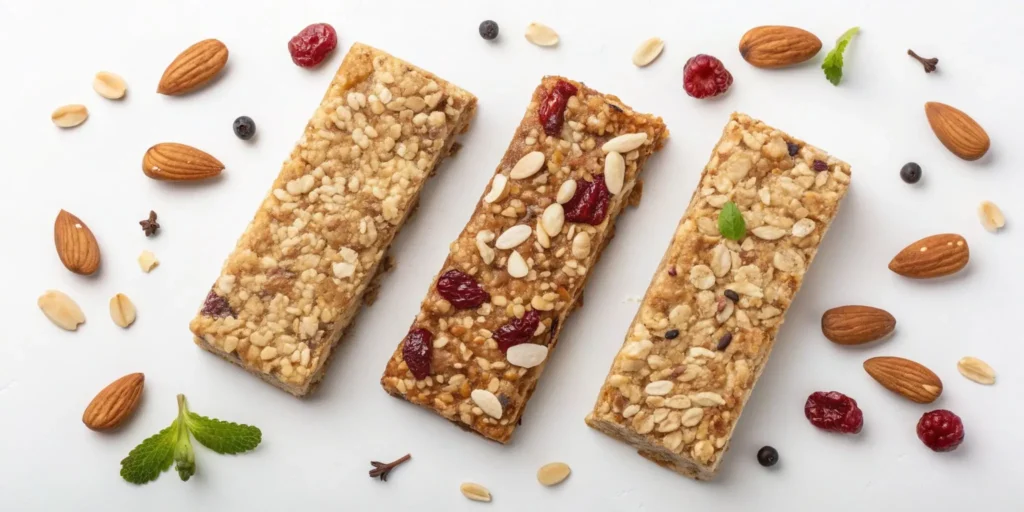
These bars are easy to customize with your favorite nuts, seeds, and dried fruits.
Ingredients:
- 1 ½ cups gluten-free rolled oats (certified)
- ½ cup mixed nuts (almonds, walnuts, pecans)
- ¼ cup dried cranberries (or other dried fruit)
- ½ cup maple syrup or honey
- ¼ cup coconut oil, melted
- 1 tsp vanilla extract
- ½ tsp ground cinnamon
Instructions:
- Preheat oven to 350°F (175°C). Line an 8×8-inch baking pan.
- Combine oats, nuts, and dried fruit in a large bowl.
- In a separate bowl, whisk together maple syrup/honey, melted coconut oil, vanilla extract, and cinnamon.
- Pour wet ingredients over dry ingredients and mix well.
- Press the mixture firmly into the prepared baking pan.
- Bake for 20-25 minutes, or until golden brown and slightly firm.
- Let cool completely before cutting into bars.
Estimated Nutritional Information per Bar (assuming a recipe yields approximately 8-10 bars):
- Calories: 200-300 kcal
- Higher calorie content due to the concentrated nature of nuts, seeds, and sweeteners.
- Macronutrients:
- Fat: 12-20g
- Saturated Fat: 2-4g (from coconut oil, nuts, and seeds)
- Unsaturated Fat: 10-16g (from nuts and seeds – focus on monounsaturated and polyunsaturated)
- Trans Fat: 0g
- Cholesterol: 0-10mg (negligible)
- Sodium: 50-100mg (varies based on added salt and ingredients like salted nuts)
- Carbohydrates: 20-30g
- Fiber: 3-5g (from gluten-free oats, nuts, and seeds)
- Sugar: 8-15g (from honey, maple syrup, and dried fruit)
- Protein: 5-8g (from gluten-free oats, nuts, and seeds)
- Fat: 12-20g
- Micronutrients (Estimates, can vary significantly):
- Iron: 4-8% of DV (from oats and nuts)
- Magnesium: 8-15% of DV (from nuts and seeds)
- Zinc: 4-8% of DV (from nuts and seeds)
- Vitamin E: Good source, depending on the type of nuts and seeds.
- Manganese: Excellent source, especially if using oats and nuts.
- Key Nutritional Highlights:
- Good Source of Healthy Fats: Provides sustained energy and supports brain function.
- High in Fiber: Promotes satiety, aids digestion, and helps regulate blood sugar.
- Moderate Source of Protein: Contributes to muscle maintenance and repair.
- Good Source of Complex Carbohydrates: Provides long-lasting energy.
- Rich in Antioxidants: From nuts, seeds, and potentially dried fruit.
- Considerations:
- Gluten-Free Oats: Ensure your oats are certified gluten-free if you have a gluten intolerance.
- Sweeteners: Be mindful of the amount of honey or maple syrup used, as it contributes to the sugar content.
- Nuts and Seeds: A great source of nutrients, but also contribute to the calorie and fat content. Choose a variety for a wider range of benefits.
- Added Ingredients: Ingredients like chocolate chips or dried fruit will increase the sugar and calorie content.
3. Spicy Roasted Chickpeas
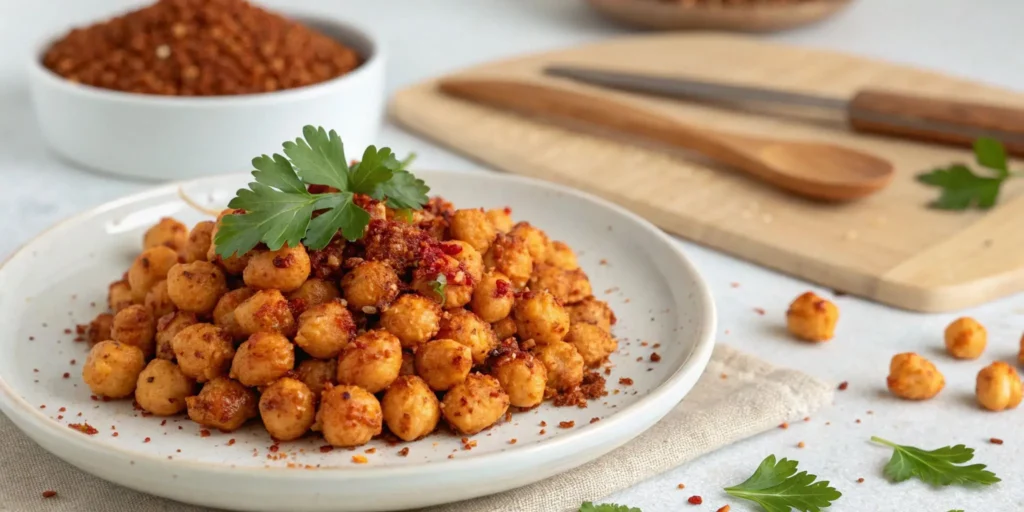
A crunchy and satisfying snack that’s high in protein and fiber.
Ingredients:
- 1 can (15 ounces) chickpeas, rinsed and drained
- 1 tbsp olive oil
- ½ tsp chili powder
- ¼ tsp cumin
- Salt and pepper to taste
Instructions:
- Preheat oven to 400°F (200°C).
- Toss chickpeas with olive oil, chili powder, cumin, salt, and pepper.
- Spread on a baking sheet and roast for 20-25 minutes, or until crispy.
Estimated Nutritional Information per 1/2 Cup Serving (assuming a recipe using a standard can of chickpeas):
- Calories: 120-180 kcal
- Varies based on the amount of oil used for roasting.
- Macronutrients:
- Fat: 5-10g
- Saturated Fat: <1g (from cooking oil)
- Unsaturated Fat: 4-9g (depending on the type of oil used – olive oil is a good choice)
- Trans Fat: 0g
- Cholesterol: 0mg
- Sodium: 5-15mg (naturally occurring in chickpeas, will increase with added salt)
- Carbohydrates: 18-25g
- Fiber: 5-7g (chickpeas are an excellent source of fiber!)
- Sugar: 2-4g (naturally occurring in chickpeas)
- Protein: 6-8g (chickpeas are a good source of plant-based protein)
- Fat: 5-10g
- Micronutrients (Estimates, can vary slightly):
- Iron: 6-10% of DV
- Folate (Vitamin B9): Good source
- Phosphorus: Good source
- Manganese: Good source
- Copper: Good source
- Key Nutritional Highlights:
- Excellent Source of Fiber: Promotes digestive health, regulates blood sugar, and can aid in weight management.
- Good Source of Plant-Based Protein: Important for muscle building and repair, especially for vegetarians and vegans.
- Relatively Low in Fat: Especially if using a minimal amount of healthy oil like olive oil.
- Good Source of Complex Carbohydrates: Provides sustained energy.
- Rich in Various Minerals: Contributes to overall health and well-being.
- Considerations:
- Type of Oil: Choose a healthy oil like olive oil, avocado oil, or coconut oil for roasting. Be mindful of the amount used.
- Sodium: Control the amount of added salt to keep sodium levels in check.
- Spices: Spices themselves are generally low in calories but high in antioxidants and can add flavor without significantly impacting the nutritional profile.
Recipe Table Summary
| Recipe | Yield | Prep Time (min) | Cook Time (min) |
| No-Bake Energy Bites | 12-15 bites | 10 | 0 |
| Chewy Gluten-Free Granola Bars | 16 bars | 15 | 20-25 |
| Spicy Roasted Chickpeas | 3-4 servings | 5 | 20-25 |
Chef’s Tips for Healthy Gluten-Free Snacking
- Read Labels Carefully: Always check food labels to ensure products are certified gluten-free and examine their nutritional content.
- Portion Control: Be mindful of portion sizes, even with healthy snacks.
- Plan Ahead: Prepare snacks in advance to avoid unhealthy impulse choices.
- Variety: Include a variety of snacks to ensure you’re getting a range of nutrients.
- Hydration: Drink plenty of water throughout the day to stay hydrated and reduce hunger.
For gluten free breakfast ideas check this article: 10 Quick and Easy Gluten-Free Breakfast Ideas
Frequently Asked Questions (FAQs) About Healthy Gluten-Free Snacks
What are good healthy gluten free snacks?
Fruits, vegetables, nuts, seeds, and yogurt are naturally great. For packaged snacks, choose certified gluten-free granola bars, rice cakes, popcorn, and corn/alternative grain chips. This guide offers many more ideas!
Are all gluten-free snacks healthy?
No. Some are high in sugar, unhealthy fats, and processed ingredients. Always check labels and prioritize snacks with whole ingredients, fiber, protein, and healthy fats, as we recommend.
What are naturally gluten free snack options?
Grab fruits like apples and berries, veggies like carrots and celery, nuts/seeds like almonds and chia seeds. Yogurt and hard-boiled eggs are also excellent, naturally gluten-free, and filling snacks.
Best gluten free snacks for weight loss?
Choose high-protein and high-fiber options like Greek yogurt, eggs, nuts, edamame, and veggies with hummus. Plain popcorn and rice cakes are lower-calorie choices in moderation.
Convenient on-the-go gluten free snacks?
Pack fruits, veggies, gluten-free granola bars, nut mixes, seed packets, or yogurt cups. Hard-boiled eggs are also portable and protein-rich.
Are popcorn and potato chips gluten-free?
Plain popcorn is naturally gluten-free. Some potato chips are, but check labels for “gluten-free” as some contain wheat starch or are cross-contaminated.
